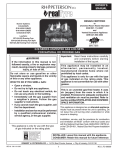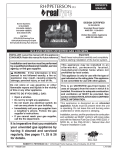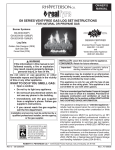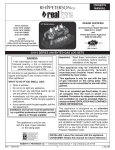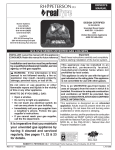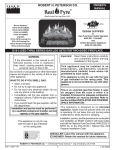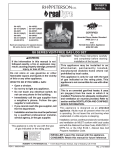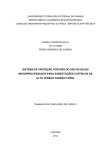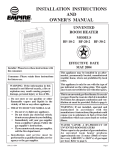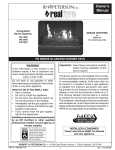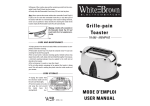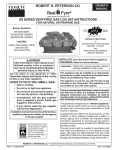Download RealFire G18 Series Owner`s manual
Transcript
MINIMUM CLEARANCE TO COMBUSTIBLES This appliance may only be installed in a listed or massonry fireplace enclosure as indicated in the IMPORTANT SAFETY INFORMATION section. If the unvented gas log set is installed in a factory-built fireplace, follow the manufacturer’s guidelines for minimum clearances to combustibles. In the absence of such guidelines, follow the instructions below: Clearances to Combustible Construction: Side walls: 6" from side of fireplace opening (Fig. 10-1) Ceiling: 42" from top of fireplace opening (Fig. 10-1) Mantel: (see Figs. 10-2, 10-3, and paragraph A below) Flooring: (see IN FRONT OF THE FIREPLACE below) Note: Clearances to combustible construction are those distances required to ensure that fireplace mantels, facings, walls, ceilings, and floorings will not catch fire. composition, previous exposure to heat, methods and quality of construction, airflow patterns, glass doors, fans, or blowers, etc. Because of these variables, we cannot guarantee that heat warping or discoloration will never occur. The potential for heat warping or discoloration may exist no matter what item(s) you are burning in the fireplace, including wood. The dimensions shown in Fig.10-1 are MINIMUM CLEARANCES to maintain when you install this gas log set. BOTH SIDES of the fireplace opening MUST Minimum clearances clearances to BE AT LEAST 6" from any toMinimum side wallsand andceiling ceiling sidewalls combustible side walls. The ceiling MUST BE at least 42" from the top of the fireplace 42" opening. 6" In most cases, these clearances should also be adequate to prevent any discoloration or warping due to heat. However, every gas log installation presents a different and unique set of circumstances involving many variables beyond the control of the gas log manufacturer. These include paint or finish Fig. 10-1 ABOVE THE FIREPLACE: To install the unvented gas log set, there must ALWAYS be noncombustible or heat-resistant material immediately above the fireplace opening. Heat-resistant materials (i.e., marble or slate) must be at least 5/8" thick. Sheet metal should not be installed onto combustible materials. If you DO NOT install a fireplace hood, there MUST be at least 12" of noncombustible or heat-resistant material immediately above the fireplace opening (see X in Fig. 10-2 below). If you DO install a fireplace hood, there MUST be at least 10" of noncombustible or heat-resistant material immediately above the fireplace opening (see Y in Fig. 10-3 below). If there is a wooden mantel, shelf, or other combustible projection above the fireplace, follow the information in Fig. 10-2 or Fig. 10-3 below. EXAMPLE: If the fireplace has a combustible projection (mantel or shelf) 20" above the top of the firebox, the maximum horizontal projection out from the face of the fireplace will be: 1. If a fireplace hood is not installed - 2.5" (see Fig. 10-2). 2. If a fireplace hood is installed - 10" (see Fig. 10-3). IF YOU CANNOT MEET THESE MINIMUM CLEARANCES, YOU MUST OPERATE THE UNVENTED GAS LOG SET WITH THE CHIMNEY FLUE DAMPER OPEN. Mantel clearance without hood Mantel clearance with hood * 14" I N F RO N T O F T H E FIREPLACE: * Standard Fireplace Hood with a minimum 4 inch horizontal projection 12" 10" Horizontal Projection From face of Fireplace 8" Be certain that c o m bu s t i bl e f l o o r i n g material (i.e., carpet, tile, etc.) is not too close to the unvented gas log set. If the unvented gas log set is at floor level or less than 6" above the floor, there MUST be at least 12" (1 foot) of noncombustible material between the front of the fireplace and any combustible flooring. 6" 2.5" Horizontal Projection From face of Fireplace 14" 12" 10" 8" .75" Non-combustible Or heat resistant Material x 34" 32" 30" 28" 25" 20" 6" 2.5" 1" Y 10" 12" Vertical distances to underside of mantel Projection out From face 0 - 0.75" 0.76" - 2.5" 2.6" - 6" 6.1" - 8" 8.1" - 10" 10.1" - 12" 12.1" - 14" Non-combustible Or heat resistant Material Height above Opening 12" 20" 25" 28" 30" 32" 34" Top of Firebox Firebox Fireplace hood with minimum 4" horizontal projection Projection out From face 0 - 1" 1.1" - 2.5" 2.6" - 6" 6.1" - 8" 8.1" - 10" 10.1" - 12" 12.1" - 14" Fig. 10-3 Fig. 10-2 10 15" 17" 20" 22" 24" Vertical distances to underside of mantel Top of Firebox Firebox 12" Height above Opening 10" 12" 15" 17" 20" 22" 24" EVENING FYRE LOGS - PARTS LIST WARNING: Failure to position these parts in accordance with these diagrams or failure to use only parts specifically approved with this unvented gas log set may result in property damage or personal injury. EVENING FYRE (EFV) LOG SET (7 PIECE) Side view Top view Front view EFV-24 24" EVENING FYRE LOG SET ITEM NO. 1. 2. 3. 4. 5. 6. 7. 8. 9. PART NO. EFVL-20BR-1 EFVL-24BF-2 EFVL-12T EFVL-13T EFVL-11TR EFVL-13TY EFVL-10T CHK-6 CHK-7 DESCRIPTION 1 Bottom rear log Bottom front log Middle left log Middle center log Middle right log Top left log Top center log Decorative wood chip Decorative wood chip 2 6 3 5 8 9 4 7 (Photos not to scale) Note: For both set sizes, each log is numbered to aid exact placement, giving the correct spacing for proper performance of the gas log set (see LOG PLACEMENT in INSTALLATION SECTION). EFV-30 30" EVENING FYRE LOG SET ITEM NO. 1. 2. 8. 9. PART NO. EFVL-24BR-1 EFVL-30BF-2 CHK-8 CHK-9 1 DESCRIPTION 2 Bottom rear log Bottom front log Decorative wood chip Decorative wood chip 30" log set contains same top logs and wood chunks as the 24" set (Items 3,4,5,6, & 7 above) 11 8 9 EVENING SPLIT LOGS - PARTS LIST WARNING: Failure to position these parts in accordance with these diagrams or failure to use only parts specifically approved with this unvented gas log set may result in property damage or personal injury. EVENING FYRE SPLIT (ESV) LOG SET (7 PIECE) Top view Front view Side view 24" LOG SET ESV-24 24" EVENING FYRE SPLIT LOG SET ITEM NO. 1. 2. 3. 4. 5. 6. 7. 8. 9. PART NO. ESVL-20BR ESVL-24BF-2 ESVL-9T ESVL-10TL ESVL-11T ESVL-12TY ESVL-8T CHK-6 CHK-7 DESCRIPTION 1 Bottom rear log Bottom front log Middle left log Middle right stripped log Middle center ripped log Top right 'Y' log Top right knotted log Decorative wood chip Decorative wood chip 5 4 6 7 3 Contact your local Real-Fyre® dealer for parts and accessories. 2 9 8 (Photos not to scale) Note: For both set sizes, each log is numbered to aid exact placement, giving the correct spacing for proper performance of the gas log set (see LOG PLACEMENT in INSTALLATION SECTION). ESV-30 30" EVENING FYRE SPLIT LOG SET ITEM NO. 1. 2. 8. 9. 1 DESCRIPTION ESVL-24BR ESVL-30BF-2 CHK-8 CHK-9 2 Bottom rear log Bottom front log Decorative wood chip Decorative wood chip 30" log set contains same top logs and wood chunks as the 24" set (Items 3,4,5,6, & 7 above). 8 12 9 EVENING FYRE CHARRED LOGS - PARTS LIST WARNING: Failure to position these parts in accordance with these diagrams or failure to use only parts specifically approved with this unvented gas log set may result in property damage or personal injury. EVENING FYRE CHARRED (EFV) LOG SET (7 PIECE) ECV-24 24" EVENING FYRE CHARRED LOG SET ITEM NO. 1. 2. 3. 4. 5. 6. 7. 8. 9. PART NO. ECVL-20BR ECVL-24BF-2 ECVL-12T ECVL-13T ECVL-11TR ECVL-13TY ECVL-10T CHK-6 CHK-7 DESCRIPTION 1 Bottom rear log Bottom front log Middle left log Middle center log Middle right log Top left log Top center log Decorative wood chip Decorative wood chip 8 2 5 3 4 9 6 7 (Photos not to scale) Note: For both set sizes, each log is numbered to aid exact placement, giving the correct spacing for proper performance of the gas log set (see LOG PLACEMENT in INSTALLATION SECTION). ECV-30 30" EVENING FYRE CHARRED LOG SET ITEM NO. 1. 2. 8. 9. PART NO. ECVL-24BR ECVL-30BF-2 CHK-8 CHK-9 DESCRIPTION 1 Bottom rear log Bottom front log Decorative wood chip Decorative wood chip 2 30" log set contains same top logs and wood chunks as the 24" set (Items 3,4,5,6, & 7 above) 8 13 9 BURNER PARTS G18-24/30-15(M)(P) 8 11 13 12 Remote kit with remote instructions included Contact your local Real-Fyre® dealer for parts and accessories. 14 9 7 Rear 1 2 10 4 6 5 3 Front Note: Photos not to scale ITEM NO. 9. or 10. 11. 12. 13. 14. ITEM DESCRIPTION NO. 1. Grate assembly 2. Valve assembly (natural) Valve assembly (propane) 3. Piezo ignitor wire 4. ON/OFF/PILOT ignitor knob 5. Main burner ON/OFF switch 6. Ember burner 7. Main burner 8. Remote kit (optional) 14 DESCRIPTION ODS pilot (natural) ODS pilot (propane) Connector kit, 30" Glowing Embers Bryte CoalsTM Lava-Fyre GranulesTM Damper clamp (for use only when burner used as a vented appliance) BURNER PARTS LIST FOR MANUAL VALVE G18-24/30(P) 13 8 11 9 9 10 6 7 12 REAR 2 1 4 3 5 Front Note: Photos not to scale ITEM NO. 1. 2. or 3. 4. 5. 6. or DESCRIPTION ITEM NO. 7. 8. 9. 10. 11. 12. 13. Grate assembly Valve assembly (natural) Valve assembly (propane) Ember burner Piezo ignitor Control knob ODS pilot (natural) ODS pilot (propane) 15 Contact your local Real-Fyre® dealer for parts and accessories. DESCRIPTION Main burner Connector kit, 30" Glowing Embers Bryte CoalsTM Lava-Fyre GranulesTM Piezo ignitor wire Damper clamp (for use only when burner used as a vented appliance) BURNER PARTS (Cont.) G18-24/30-12(M)(P) 7 14 8 13 Remote kit with remote instructions included 9 12 5 4 1 Rear 6 3 11 Contact your local Real-Fyre® dealer for parts and accessories. 2 Front 10 ITEM DESCRIPTION NO. 1. Grate assembly 2. Valve assembly (natural) Valve assembly (propane) 3. Ember burner 4. ODS pilot (natural) ODS pilot (propane) 5. Main burner 6. Connector kit, 30" 7. Glowing Embers Note: Photos not to scale ITEM NO. 8. 9. 10. 11. 12. 13. 14. 16 DESCRIPTION Bryte CoalsTM Lava-Fyre GranulesTM ON/OFF switch Piezo ignitor Piezo wire Damper clamp (for use only when burner used as a vented appliance) Remote kit (optional) BURNER PARTS (Cont.) Contact your local Real-Fyre® dealer for parts and accessories. G18-24/30-01V(P) Note: Photos not to scale 13 8 10 9 5 Front Rear 3 1 6 7 11 12 AA battery compartment (on side) 4 2 ITEM NO. 7. 8. 9. 10. 11. 12. 13. ITEM DESCRIPTION NO. 1. Grate assembly 2. 01 series electronic valve assembly with built in receiver 3. Main burner 4. Ember burner 5. ODS pilot (natural) or ODS pilot (propane) 6. Gas connector 17 9 volt battery compartment (at rear) DESCRIPTION Remote handset (supplied) Glowing Embers Bryte CoalsTM Lava-Fyre GranulesTM AA batteries (4) - (see inset above) 9-volt battery (1) - (see inset above) Damper clamp (for use only when burner used as a vented appliance) WHEN USED AS A VENTED DECORATIVE APPLIANCE (PER ANSI Z21.60b-2004) This appliance is for installation in a solid-fuel-burning fireplace (masonry fireplace or manufactured fireplace) with a working flue and constructed of noncombustible material. These gas logs may be installed as vented decorative log sets in compliance with ANSI Z21.60b-2004 and National Fuel Gas Code, Section 6.6. The minimum permanent free opening of the fireplace chimney or chimney damper must be met per the Chimney Vent Opening Table on pg 3 of this manual. Chimney damper must be fixed in a manner to maintain permanent free opening at all times. To accomplish this, install a screw or bolt in the edge of the damper to prevent closing, or drill holes in the damper or remove the damper. CONNECTING THE GAS TO THE BURNER SYSTEM BEFORE PROCEEDING, CAREFULLY READ ALL OF THE IMPORTANT SAFETY INFORMATION CONTAINED IN THIS OWNER’S MANUAL, INCLUDING: A. Pre-Installation and Fireplace Preparation Safety Guidelines B. Ventilation and Confined Space Information C. Installation Safety Guidelines I M P O R T A N T Be sure you have read and understand all safety precautions and warnings contained in this manual. Note: To install the unvented gas log set, the fireplace must have a gas-supply line that has been installed by a qualified professional service technician in accordance with all local codes. Refer to the PARTS LIST when installing the unvented gas log set. Tools Required: 1. Adjustable open-ended wrench 4. Soapy water solution and brush for leak detection 2. Pliers 5. Standard screwdriver 3. Propane gas-resistant pipe compound or Teflon 6. Manometer (for checking gas pressure) tape CHECK GAS TYPE (natural or propane). The gas supply must be the same as stated on the gas log set rating plate. If the gas supply is different, DO NOT INSTALL. Contact the dealer for immediate assistance. W A R N I N G Do not connect this appliance directly to a high-pressure natural gas line or an unregulated propane tank. Refer to the PARTS LIST when installing the unvented gas log set. 1. MAKE SURE THE FIREPLACE GAS SUPPLY IS TURNED OFF. 2. Center the burner assembly in the fireplace. Make certain that no part of the assembly protrudes beyond the face of the fireplace. 3. Attach the large adapter fitting of the flex connector kit to the fireplace gas-supply line using pipe compound resistant to propane gas or Teflon tape. Tighten the connection. Connect one end of flex connector to the large adapter and the other end to the adapter on the valve assembly. LEAK TESTING Make sure that the control valve on the burner system is in the OFF position. Carefully turn on the gas to the fireplace and leak test at all connections with a soapy water solution (equal parts liquid detergent and water). If bubbles appear, a leak is present. Turn off the gas and tighten all connections, then turn on the gas and repeat the leak test. Repeat until no leaks are detected. NEVER USE A FLAME TO CHECK FOR GAS LEAKS. 18 INSTALLATION IMPORTANT For all valves, the air MUST be purged from the gas line before the ODS pilot will light properly. The time taken to do this will depend on the length of gas line from the meter to the unit and the length of time since the unit or gas line was last used (in the case of non-use during warm weather, for example). It may take from 3-15 minutes before all the air is purged and the ODS pilot will light properly. This is done using different methods, depending on which valve is fitted to the unit. Follow the LIGHTING INSTRUCTIONS in this manual for the specific valve type. A. G18-24/30-01V(P) - Hold down control knob at PILOT (see Fig. 19-4). B. G18-24/30-15(M)(P) - Hold in control knob at PILOT (see Fig. 19-3). CONTROL SETTINGS We recommend that before you install the log set, you familiarize yourself with the control valve layout. This will help you to be confident operating the log set when fully installed. See the figures below for typical control positions. OFF Manual gas valve operating positions OFF PILOT ON/HIGH ON/LOW Valve switch set to O Fig. 19-1 Flame control turned OFF PILOT ON 12 series remote-capable gas valve operating positions OFF PILOT ON Valve switch set to I Read setting here Fig. 19-2 Flame control turned OFF ON 15 series remote-capable gas valve operating positions OFF IGNITION PILOT ON Valve switch set to I Flame control turned ON Fig. 19-3 Fig. 19-4 19 INSTALLATION (Cont.) I M P O R T A N T Check the gas pressure with the unvented gas log set burning and the control set to HIGH. The gas log set and its main gas valve must be disconnected from the gas-supply piping system during any pressure testing of that system at test pressures in excess of 1/2 psig (3.5 kPa). The gas log set must be isolated from the gas-supply piping system by closing its equipment shutoff valve during any pressure testing of the gas-supply piping system at test pressures equal to or less than 1/2 psig (3.5 kPa). This is accomplished by closing the gas-supply line valve. CHECKING GAS PRESSURE Remote-capable safety pilot valve (15 series) (Fig. 20-1) Manual safety pilot valve (Fig. 20-2) Check the valve regulator pressure at the pressure inlet point. Turn the inlet screw counterclockwise 2 or 3 turns and then place the tubing of the pressure gauge over the pressure inlet point. (The test “inlet” tap is farthest to the gas-supply inlet.) After taking the pressure reading, turn the inlet screw clockwise firmly to reseal. Do not over-torque. Check for gas leaks. The pressure regulator is preset at the factory and locked to discourage tampering. If the pressure is not as specified, replace the regulator with the correct part from the PARTS LIST in this manual. To check the pressure, remove 1/8" pressure tap screw plug, located on the side of the regulator body. Install fitting and tubing of pressure gauge. With the unit operating, take the pressure reading. Reinstall the pressure tap screw and check for leaks when done. Regulator Fig. 20-1 Fig. 20-2 Inlet Outlet Pressure tap plug The unvented burner system will need to be propped up to allow access to the pressure inlet and outlet points on the bottom side of the valve. Note: Gas pressure should be checked after connecting the gas and prior to any further installation. GAS PRESSURE SPECIFICATIONS NATURAL GAS MANUAL PRESSURE Regulator pressure reading: Gas inlet pressure: MILLIVOLT PRESSURE 3.5" w.c. Outlet pressure reading: (Flame adjustment on high) Max. 10.5" w.c. Min. 5" w.c. Inlet pressure reading 3.5" w.c. Max. 10.5" w.c. Min. 5" w.c. PROPANE (L.P.) GAS MANUAL PRESSURE Regulator pressure reading: Gas inlet pressure: MILLIVOLT PRESSURE 10" w.c. Outlet pressure reading: (Flame adjustment on high) Max. 13" w.c. Min. 11" w.c. 20 Inlet pressure reading 10" w.c. Max. 13" w.c. Min. 11" w.c. INSTALLATION (Cont.) LAVA-FYRE GRANULESTM PLACEMENT Lava-Fyre GranulesTM are provided as an aesthetic enhancement to the G18 unvented gas log set. Spread the granules (see Parts List) on the floor of the firebox around the front and the sides of the unvented gas log set. BE SURE THAT NO GRANULES ENTER THE MAIN BURNER OR INTERFERE WITH THE BURNING OF THE LOG SET. GLOWING EMBER PLACEMENT The Glowing Embers are supplied in a single bag (Fig. 21-1). It is important that the embers be used in the designated application and that no additional embers be added. Open the bag and spread the embers loosely along the entire length of the ember burner (Fig. 21-3) from left to right on the burner and on the vertical portion of the ember burner. Break up any clumps that may have developed during shipment, and make sure the embers are spread evenly over the entire area. Bryte CoalsTM are placed over the glowing embers, also spreading out evenly (Figs. 21-2, 21-3). Failure to follow these instructions will result in unsafe operation. Fig. 21-1 Fig. 21-2 Important: Fig. 21-3 Do not add any additional embers or Bryte CoalsTM to this log set. Any additional embers may cause unsafe operation. WARNING All previously applied loose material, such as embers, must be removed prior to reapplication. All replacement loose material must be purchased from the original appliance manufacturer. WARNING: Failure to position the parts in accordance with these diagrams, or failure to use only parts specifically approved with this log set, may result in property damage or personal injury. 21 INSTALLATION (Cont.) EVENING FYRE / EVENING FYRE CHARRED LOG PLACEMENT Log placement is critical to ensure stability of the logs and proper performance of the Real-Fyre® gas log set. Be sure to follow the log placement instructions carefully! (Reference the appropriate LOGS PARTS LIST.) 1. Each log in the Real-Fyre® unvented gas log set is numbered to aid in the log placement procedures. Set the rear log at the back of the burner. Slide it forward so that the rear of the main burner bracket fits into the two (2) locating grooves in the front face of the log. Align the bottom of the front log with the corresponding holes found in the burner. (See Fig. 22-1.) (Evening Fyre shown) A Ensure notches in face of REAR log slide over rear of bracket 1 2 A Fig. 22-1 2. Position the middle logs (Logs #3, #4, and #5) on top of the bottom logs. Locate the logs so that each log rests in the corresponding slots on the bottom front log and bottom rear log (see Fig. 22-2). 3. Position the top left log (Log #6) on the top of the middle logs # 3 and #4, and bottom front log. Locate the top center log (Log #7) on top of Log #6 and Log #4. The logs should rest in the corresponding slots. (See Fig. 22-3). 4 3 Fig. 22-2 Fig. 22 22-3 22- 6 5 6 7 7 After setting the logs into position as described above, ensure each is properly and firmly seated. The unvented gas log set will not function as intended if the logs are not correctly positioned. When placed properly, the flames will not strike any portion of logs #3, 4, 5, 6, or 7. Periodically check the positioning of all logs to ensure proper log placement and stability. If any flame is striking any of the logs, recheck log placement. Adjust to conform with instructions. There should be no flame touching these logs. CAUTION: BURN HAZARD. Logs will remain hot for some time after use. You must maintain the log layout as shown to ensure proper operation of the log set. If you need to reposition any log to maintain the proper layout, use heat-resistant gloves or allow logs adequate time to cool before handling. WOOD CHIP PLACEMENT The decorative wood chips provided with the log set are for aesthetics only and do not affect operation of the G18 series unvented gas log set. The wood chip with the circular design should be placed in front of the valve, with at least a 1/2 inch between it and the valve. The other wood chip should be placed on the opposite side (see Fig. 22-4). Note: The wood chip may be HOT during and directly after operation of the gas log set. Do not place the wood chip on or in the log set. 22 Wood chip (circular design) Fig. 22-4 Wood chip INSTALLATION (Cont.) EVENING FYRE SPLIT LOG PLACEMENT Log placement is critical to ensure stability of the logs and proper performance of the Real-Fyre® gas log set. Be sure to follow the log placement instructions carefully! (Reference the appropriate LOGS PARTS LIST.) 1. Each log in the Real-Fyre® unvented gas log set is numbered to aid in the log placement procedures. Set the rear log at the back of the burner. Slide it forward so that the rear of the main burner bracket fits into the two (2) locating grooves in the front face of the log. Align the bottom of the front log with the corresponding holes found in the burner. (See Fig. 23-1.) A 1 Ensure notches in face of REAR log slide over rear of bracket 2 A Fig. 23-1 2. Position the middle logs (Logs #3, #4 and #5) into the appropriate grooves on the bottom logs as shown in Fig. 23-2. 3. Position the two top logs (Logs #6 and #7) into the grooves atop logs #3, #4, and #5 as shown in Fig. 23-3. 4 Fig. 23-3 Fig. 23-2 5 7 6 3 24" log set shown Each log must be properly and firmly situated. The unvented gas log set will not function as intended if the logs are not correctly positioned. When placed properly, the flames will not strike any portion of logs #3, 4, 5, 6, or 7. Periodically check the positioning of all logs to ensure proper log placement and stability. If any flame is striking any of the logs, recheck log placement. Adjust to conform with instructions. There should be no flame touching these logs. CAUTION: BURN HAZARD. Logs will remain hot for some time after use. You must maintain the log layout as shown to ensure proper operation of the log set. If you need to reposition any log to maintain the proper layout, use heat-resistant gloves or allow logs adequate time to cool before handling. Place the wood chips as instructed and shown on the bottom of the previous page. 23 INSTALLATION (Cont.) DAMPER CLAMP INSTRUCTIONS (IF APPLICABLE) The damper clamp with hex bolt (Fig. 24-1) is provided as a means to prevent full closure of the damper blade. The clamp is easily attached to most damper blades with pliers or a wrench, and must be permanently installed. The clamp is designed to prevent accidental closure of the damper when installed as illustrated (Fig. 24-2 and Fig. 24-3). Should the Damper clamp clamp not fit, or fail to provide the permanent vent Set screw opening specified in Table 3-1, have a permanent stop installed, remove the damper blade, or have the damper cut to provide the minimum permanent opening required. Fig. 24-1 Open Closed Fig. 24-2 Fig. 24-3 CLEANING AND SERVICING SAFETY INFORMATION Note: Regular cleaning and servicing will be necessary to ensure proper ODS pilot operation and proper burn characteristics. A. Always shut off the gas to the unvented gas log set while performing service work. B. Allow the unvented gas log set to cool before servicing. C. Installation and repair must be done by an NFI Certified or other qualified professional service technician. The gas log set should be inspected regularly to prevent burner shutdown, sooting, odors, etc. This unit must be inspected and cleaned annually by a qualified professional service technician. It must be checked for clean burning operation and proper ODS pilot appearance, with the correct tools to service this unit. More frequent cleaning may be required. Excessive lint can build up on this unit from carpeting, bedding material, pet hairs, or other particles in the air. It is critical that all control components, burners, and circulating air passageways be kept clean and free of all obstructions. The ODS pilot is especially sensitive to a dirty environment and will not function properly if dirty. Make certain all air openings are clean and free of obstructions, including: 1. 2. 3. 4. The air intake opening on the ODS pilot assembly. The ODS pilot opening. The air shutters on both the front/bottom ember burner and the rear/top main burner. The flash tube and its corresponding carryover ports. Obstructions in or around the flash tube may result in the ember burner not lighting and/or an intermittent popping noise from the flash tube. WARNING: Failure to keep the primary air openings of the burner(s) clean may result in sooting and property damage. 5. All of the ports on both the front/bottom ember burner and the rear/top main burner. (See the CLEANING AND SERVICING section.) D. Any safety screen or guard removed for servicing must be replaced prior to operating this gas log set. E. Decorative wood chip (if included) must be placed at least a 1/2 inch away from burner controls to avoid damaging the controls by overheating due to heat reflection (see Fig. 24-5). Main burner ODS pilot (in rear) ports Fig. 24-4 Fig. 24-6 1/2" (minimum) Flash tube ODS pilot opening ODS pilot Carryover port location (for flash tube) Gas valve Air intake opening Ember burner ports Fig. 24-5 24 CLEANING AND SERVICING Only limited cleaning will be required under normal use of the unvented gas log set. TO CLEAN THE LOG SET 1. Remove the log set and embers. Use a vacuum cleaner to remove loose particles from all surfaces of the log set. Do not use cleaning fluids. 2. Dust the grate, the assembly, and the burners. Using a compressed air duster (commonly available at computer, electronic, or office supply stores); blow through the flash tube, its corresponding carry over port, and all of the burner ports. See Fig. 25-4 on the previous page for locations. 3. Reinstall the log set and embers as instructed in this manual. If, after a period of use, the flames start to exhibit unusual shapes and behavior, or the burners fail to ignite smoothly, the burner ports may require some cleaning. If this happens, it is preferable to contact the nearest dealer to get the unvented gas log set serviced. ODS pilot gas line connects here ODS pilot opening Air intake opening Fig. 25-1 Do not remove the rating plates or the warning tags. These are an integral safety and identification component of this appliance. During periods of heavy use, inspect the unvented gas log set frequently for evidence of sooting. If sooting is present, discontinue use until the source of sooting is corrected. CLEANING AND SERVICING THE ODS PILOT Periodic cleaning and maintenance of the unvented gas log set is recommended to ensure that the log set operates properly. Cleaning of the ODS pilot system is an important part of the maintenance program. This ODS pilot cleaning procedure must be performed by a qualified professional service technician familiar with the specific characteristics of the log set. 1. Turn the unvented gas log set to the OFF position and allow it to cool. Inspect the ODS pilot area (see Fig. 25-1) for any visual contamination or debris (usually lint, hair, spider webs, or small insects). Lightly brush off all external surfaces while vacuuming loosened debris from the ODS pilot opening. Be careful not to brush any foreign material into the ODS pilot opening. 2. Clean out the air intake opening (see Fig. 25-1) by lightly brushing around the opening while vacuuming. Note: It is very important that the air intake opening be kept clear of debris. Should the opening become blocked, the ODS pilot system will not operate properly. 3. Light the ODS pilot according to the relevant LIGHTING INSTRUCTIONS page. Periodically verify the ODS pilot flame appears as shown in the CHECKING THE ODS PILOT FLAME APPEARANCE section. 4. If the ODS pilot flame does not burn as indicated in the instructions, extinguish the ODS pilot by turning the valve to the full OFF position. Using a compressed air duster, insert the flexible nozzle through the air intake opening, ensuring that the nozzle is pointed toward the ODS pilot opening (see Fig. 25-1). Blow air through the intake opening to clear out any debris that may be in the system. 5. Relight the ODS pilot and inspect it to be sure it is burning as shown in the instructions. If not, extinguish the ODS pilot and turn off the gas supply to the gas log set. Using an adjustable or a 1/4" wrench, disconnect the ODS pilot gas line (see Fig. 25-1) from the valve. 6. Insert the flexible nozzle of the compressed air duster and blow air into the input end of the ODS pilot gas line to remove any blockages. Do not blow air directly into the ODS pilot opening. Blow air in the direction of the gas flow. 7. Reinstall the ODS pilot gas line and check for leaks. 8. Light the ODS pilot to make sure it is operating properly (see LIGHTING INSTRUCTIONS). 9. If the ODS pilot still does not operate properly, the ODS pilot may need to be replaced with the same model as the one on the unvented burner. 25 OPERATING THE UNVENTED GAS LOG SET Observe the flames. The main burner flames should be blue at the base and a combination of blue/yellow at the body and at the tips. They should be 5" to 8" above the logs, with the center flame being the tallest (see Fig. 26-1). Front flames in the ember burner should be 1/4" above the embers. Every Real-Fyre unvented gas log set leaves the factory tested and quality checked to ensure that it has been manufactured to the strict specifications to which it was submitted and approved for certification. This check includes an operational test to ensure both satisfactory combustion and operation. Each installation site for any unvented appliance presents its own unique combustion Fig. 26-1 environment. Specific factors such as weather-tightness of the home, size of the room in which the log set is installed, central heating, ceiling fans, altitude, drafts, pet hair, carpet lint, dryer lint, the size of the fireplace, paint or soot inside the fireplace, etc. all have an influence on the proper operation of an unvented appliance and its ODS pilot system. A normally operating unvented log set will demonstrate the following characteristics: • A lively, realistic flame and front ember glow. The flame will be blue/yellow on the front burner and on the rear burner. • Clean-burning combustion that will produce no soot or smoke after normal break-in. • Production of no odor, other than normal odors associated with the combustion of propane or natural gas. • Production of water vapor. Water vapor helps to increase indoor humidity, which may be beneficial during the dry heating season. If you operate the unvented gas log set fueled by propane gas, operating characteristics may vary as the fuel in the tank approaches empty (less than 1/4 full). Sooting and other increases in combustion by-products will occur. Turn off the log set and refill the propane tank. CHECKING THE ODS PILOT FLAME APPEARANCE WARNING: NO ADJUSTMENTS ARE TO BE MADE TO THE ODS PILOT SYSTEM. TAMPERING WITH THIS SYSTEM CAN BE EXTREMELY HAZARDOUS. When installing the burner assembly, it is important to visually check the ODS pilot flame and the burner flames. 1. The ODS pilot flame must be present when the burner is operating. The flame should touch the top of the thermocouple tip (Fig. 26-2 and Fig. 26-4). 2. If the ODS pilot flame does not touch the top of the thermocouple tip, then the main burner will not function properly (see Fig. 26-3 and Fig. 26-5 for incorrect ODS pilot flame). 3. With the burners off and the ODS pilot flame off, and the assembly cool, check the burner assembly, air intake openings on the ODS pilot, and air shutter openings on the burner for any blockages that could affect the operation of the ODS pilot flame. ODS Pilot for Manual, 01, and 15 valve ODS Pilot for 12 valve (NG shown) (NG shown) Correct ODS pilot flame Fig. 26-2 Incorrect ODS pilot flame Fig. 26-3 Correct ODS pilot flame Fig. 26-4 26 Incorrect ODS pilot flame Fig. 26-5 LIGHTING INSTRUCTIONS - SERIES 15 VALVE FOR YOUR SAFETY, READ BEFORE LIGHTING WARNING If you do not follow these instructions exactly, a fire or explosion may result, causing property damage, personal injury, or loss of life. Do not use this appliance if any part has been underwater. Immediately call for a qualified professional service technician to inspect the appliance and to replace any part of the control system and any gas control that has been underwater. The Real-Fyre® burner system has an ODS pilot. When starting the ODS pilot, follow these instructions exactly. BEFORE LIGHTING, smell all around the gas burner system area for gas. Be sure to smell next to the floor, as some gas is heavier than air and will settle on the floor. IF YOU SMELL GAS, FOLLOW THE INSTRUCTIONS ON P. 1. Use only your hand to push in or turn the gas control knob. Never use tools. If the knob will not push in or turn by hand, don't try to repair it. Call a qualified professional service technician. Force or attempted repair may result in fire or explosion. (Fig. 27-4) to ignite the burner at maximum BTU. After the main burner ignites, adjust the flame height as indicated below. LIGHTING THE ODS PILOT 1. Turn the ignitor control knob (Fig. 27-1) on the burner control valve assembly to the side of the burner pan counterclockwise so that the narrowing part of the knob moves from the OFF position, slightly toward IGN, until reaching the stop. ADJUSTING THE FLAME HEIGHT 1. To adjust the flame, turn the flame-height control knob (Fig. 27-3) counterclockwise to increase the flame height, or clockwise to decrease the flame height, until the flames have the desired characteristics. 2. Press the ignitor control knob in and hold in for five seconds (only ODS pilot gas will flow). 3. Continue pressing in while turning the ignitor control knob further counterclockwise toward the PILOT position, until you hear a click. The click is an indication that the piezo ignitor has been activated. Note: If the spark from the piezo ignitor does not light the ODS pilot, repeat steps 2 & 3 until the ODS pilot lights. 2. When you are finished enjoying your fire, turn the flame-height control knob to OFF. The ODS pilot will remain lit. The burner system can be relit by rotating the flame-height control knob toward ON. SHUTTING OFF THE ODS PILOT If you do not plan on using your burner system for an 4. Continue to hold the ignitor control knob in the PILOT extended period, you may elect to extinguish the ODS pilot. position for 30 seconds after the ODS pilot has been lit to To do this, rotate the flame-height control knob to the OFF allow the thermocouple to detect the ODS pilot flame. position and then rotate the ignitor control knob to the OFF position (Fig. 27-1). Note: The ODS pilot flame should always be present Important: When shutting your burner down, be sure when the burner system is in operation, and should to TURN THE FLAME FULLY OFF (to just envelop the tip of the thermocouple. PILOT or OFF). Make sure the burner IGNITING THE MAIN BURNER is completely off for one minute before relighting. 1. When the ODS pilot flame is stable, release the ignitor to the ON control knob and turn counterclockwise position to enable the main burner. If this unit was shipped with a remote, or if a remote 2. Tur n the flame-height control knob (Fig. 27-3) system was installed later, read and follow the separate to the fully ON position counterclockwise remote instructions to operate the burner remotely. OFF IGNITION PILOT ON Ignition control knob Flameheight control knob Gas valve operating positions Fig. 27-1 Fig. 27-3 Flame touching Flame-height control knob Fig. 27-2 Thermocouple OFF 27 Fig. 27-4 ON LIGHTING INSTRUCTIONS - MANUAL VALVE FOR YOUR SAFETY, READ BEFORE LIGHTING WARNING: If you do not follow these instructions exactly, a fire or explosion may result, causing property damage, personal injury, or loss of life. Do not use this appliance if any part has been underwater. Immediately call for a qualified professional service technician to inspect the appliance and to replace any part of the control system and any gas control that has been underwater. The Real-Fyre® burner system has an ODS pilot. When starting the ODS pilot, follow these instructions exactly. BEFORE LIGHTING, smell all around the gas burner system area for gas. Be sure to smell next to the floor as some gas is heavier than air and will settle on the floor. IF YOU SMELL GAS, FOLLOW THE INSTRUCTIONS ON P. 1. Use only your hand to push in or turn the gas control knob. Never use tools. If the knob will not push in or turn by hand, don't try to repair it. Call a qualified professional service technician. Force or attempted repair may result in fire or explosion. LIGHTING THE ODS PILOT IGNITING THE MAIN BURNER 1. Push in the gas control knob (Fig. 28-1) slightly and turn clockwise to OFF. Note: The burner control knob cannot be turned from PILOT to OFF unless the handle is pushed in slightly. Do not force. 2. Turn the control knob on the gas valve counterclockwise to PILOT. 1. Push in slightly and rotate your manual control knob in a counterclockwise direction to the ON/HIGH position (first stop past PILOT position, see Fig. 28-2). The main burner will ignite at maximum BTU. ADJUSTING THE FLAME HEIGHT 1. To lower the setting, push in slightly and continue to turn direction. When you reach in a counterclockwise the stop, your burner is at minimum LOW position. Note: The burner control knob cannot be turned from OFF to PILOT unless the handle is pushed in slightly. Do not force. Wait five minutes to clear out any gas. If you then smell gas, STOP! Notify your gas supplier or the fire department immediately. If you don’t smell gas, go on to step 2. 3. Push in on the control knob all the way and hold in. Immediately light the ODS pilot with a long-neck butane lighter or press in ignitor button (Fig. 28-1) to light the ODS pilot. Continue to hold the control knob in for approximately 30 seconds after the ODS pilot is lit. Release the knob, and it will pop back out. The ODS pilot should remain lit. If it goes out, repeat steps 4 through 5. 2. To turn off the main burners only, push in slightly and rotate the manual control knob clockwise to the PILOT position. The ODS pilot flame will remain lit. SHUTTING OFF THE ODS PILOT If you do not intend to use your log set for an extended period of time, you may elect to turn the manual control knob to the OFF position. This will extinguish the ODS pilot. The next time you use the set, you will have to light the ODS pilot as described in LIGHTING THE ODS PILOT. Note: When shutting your log set down, be sure to TURN THE FLAME COMPLETELY TO THE OFF • If the knob does not pop back out when released, POSITION. Make sure the burner is completely stop and immediately call your service technician or off for one minute before relighting! gas supplier. If this unit was shipped with a remote, or if a remote system • If the ODS pilot will not stay lit after several tries, follow was installed later, read and follow the separate remote the instructions for SHUTTING OFF THE ODS PILOT instructions to operate the burner remotely. and call your service technician or gas supplier. OFF Manual valve system PILOT ON/HIGH ON/LOW Fig. 28-1 Manual gas valve operating positions Fig. 28-2 Piezo ignitor WARNING: NO ADJUSTMENTS ARE TO BE MADE TO THE ODS PILOT SYSTEM. TAMPERING WITH THIS SYSTEM CAN BE EXTREMELY HAZARDOUS. Control knob 28 OPERATING THE LOG SET - LIGHTING AND EXTINGUISHING (Cont.) FOR YOUR SAFETY, READ BEFORE LIGHTING WARNING If you do not follow these instructions exactly, a fire or explosion may result, causing property damage, personal injury, or loss of life. LIGHTING INSTRUCTIONS FOR THE G18-12 (M)(P) BURNER SYSTEM 1. Locate your Series 12 control valve (p. 15). Turn the control knob (Fig. 29-4) from the OFF position (see Fig. 29-1) slightly counterclockwise to PILOT (see Fig. 29-2). Press the control knob in and hold for 10 seconds (only pilot gas will flow). Continue pressing control knob and push the piezo ignitor (see Fig. 29-4). You should hear a click, and pilot should light. Repeat this step until the pilot lights. Continue to hold the control knob in the PILOT position for 30 seconds after the pilot has been lit. The flame height and heat output of your log set can be adjusted by turning the flame height knob (see Figs. 29-4, 29-5) to HI or LO as you wish to reach your desired heat level/flame height. When you are finished enjoying your log set, simply move the burner toggle switch to OFF (down). In this position, the pilot will remain lit, and the log set can be relit by moving the switch to ON. If you do not plan on using your log set for an extended period, you may elect to extinguish the pilot. To do this, 2. The pilot flame should now remain lit. It should move the toggle switch to OFF, then rotate the control always be present when the unvented gas log set knob clockwise , depressing the knob slightly as is in operation and should just envelop the tip of you pass PILOT, to the OFF position (a stop). This thermocouple. If pilot light goes out, repeat step 1. will require that you relight the pilot before you use If pilot will not stay lit after several tries, follow the the log set again. instructions TO TURN OFF GAS TO APPLIANCE in Note: When completely shutting your log set your Owner’s Manual and call your service technician down, be sure to TURN THE FLAME FULLY or gas supplier. OFF (turn from ON through PILOT to OFF). Make sure the burner is completely off for 1 3. When the pilot flame is stable (remains lit), release minute before relighting! the control knob and turn counterclockwise to the ON position (see Fig. 29-3) (at stop). If this unit was shipped with a remote, or if a 4. To ignite main burner, move burner ON/OFF toggle switch remote system was installed later, read and follow the separate remote instructions to (see Fig. 29-4) to ON (up). Main burner will ignite. operate the burner remotely. Fig. 29-1 OFF position OFF POSITION READ SETTING Read setting here HERE Fig. 29-2 PILOT position PILOT POSITION READ SETTING Read setting here HERE Control CONTROLknob KNOB (ON/OFF/PILOT) ON/OFF/PILOT FlameHEIGHT height knob FLAME KNOB (HI/LOW) HI/LO Fig. 29-3 ON ONposition POSITION Read setting here READ SETTING HERE HI/LOW HI/LO PiezoIGNITOR ignitor PIEZO Fig. 29-4 Burner BURNER ON/OFF SWITCH switch ON/OFF 29 Fig. 29-5 LIGHTING INSTRUCTIONS - 01V(P) VALVE FOR YOUR SAFETY, READ BEFORE LIGHTING WARNING: If you do not follow these instructions exactly, a fire or explosion may result, causing property damage, personal injury, or loss of life. Do not use this appliance if any part has been underwater. Immediately call for a qualified professional service technician to inspect the appliance and to replace any part of the control system and any gas control that has been underwater. The Real-Fyre® burner system has an ODS pilot. When starting the ODS pilot, follow these instructions exactly. BEFORE LIGHTING, smell all around the gas burner system area for gas. Be sure to smell next to the floor, as some gas is heavier than air and will settle on the floor. IF YOU SMELL GAS, FOLLOW THE INSTRUCTIONS ON PAGE 1. Use only your hand to push in or turn the gas control knob. Never use tools. If the knob will not push in or turn by hand, don't try to repair it. Call a qualified professional service technician. Force or attempted repair may result in fire or explosion. LIGHTING THE ODS PILOT 1. Locate your electronic control valve (see PARTS LIST, Item 2). Turn the control arrow to MAN for manual mode (see Fig. 30-1). 2. Press the ON/OFF switch from O to I (see Fig. 30-1). Using a small bladed screwdriver or similar, press and hold the button within the hole on the control (see Fig. 30-2). Using a long-neck butane lighter, ignite the ODS pilot flame. Hold in the button for about 1 minute (or longer if first use or after a long period of non-use). 3. The ODS pilot flame should now remain lit. It should always be present when the gas log set is in operation and just envelop the tip of thermocouple. If the ODS pilot light goes out, repeat steps 1-2. If the ODS pilot will not stay lit after several tries, follow the instructions TO TURN OFF GAS TO APPLIANCE in your owner’s manual and call your service technician or gas supplier. height is reached (counterclockwise to increase, to decrease). clockwise 2. To turn off just the main burners, turn the flame height control knob fully clockwise until flame is extinguished. The ODS pilot flame will remain lit. SHUTTING OFF THE ODS PILOT If you do not plan on using your log set for an extended period you may elect to extinguish the ODS pilot. To do this, press the I/O switch on the valve to O. This will completely shut down the log set (main burners and ODS pilot will extinguish). This will require that you relight the ODS pilot before you use the log set again. To do so, follow steps 1-2 above. Always turn flame height control knob to the OFF position when shutting it down. Note: When completely shutting your log set down, be sure to TURN THE (I/O) SWITCH ON THE VALVE TO O (OFF). Make sure the burner is completely off for 1 minute before relighting! IGNITING THE MAIN BURNER 1. When the ODS pilot flame is stable (remains lit, beeping stops), turn the control knob to ON. Turn the flame height control knob counterclockwise past ON; gas will flow to the main burner, and the main burner will ignite. The ember burner will ignite shortly afterward. To operate the burner using a remote handset and receiver, follow the instructions supplied with the remote. CHECKING THE ODS PILOT FLAME 1. The ODS pilot flame must be present when the burner is operating. The flame should touch the top of the thermocouple tip (Fig. 30-4). 2. If the ODS pilot flame does not touch the top of the thermocouple tip, then the main burner will not function properly (see Fig. 30-5 for incorrect ODS pilot flame). 3. With the burners off, the ODS pilot flame off, and the assembly cool, check the burner assembly, air intake opening on the ODS pilot, and air shutter openings on the burner for any blockages that could affect the operation of the ODS pilot flame. ADJUSTING THE FLAME HEIGHT 1. To adjust the flame height, turn the flame height control knob (see Fig. 30-3) until the desired flame ON/OFF switch Fig. Press & hold 30-1 button at bottom Fig. 30-2 of hole ODS PILOT FOR REMOTE VALVES Turn arrow to MAN (NG shown) Flame not touching Flame touching When the ODS pilot is stable, tur n flame height control knob counterclockwise to ignite burner. Adjust for flame height as desired. Thermocouple Fig. 30-3 Fig. 30-4 Correct ODS pilot flame 30 Thermocouple Fig. 30-5 Incorrect ODS pilot flame TROUBLESHOOTING POSSIBLE CAUSE 1 SOLUTIONS BURNER SHUTTING DOWN DURING OPERATION A. Insufficient or excessive gas pressure A1. Check gas pressure (check with local gas company). For natural gas, pressure must be minimum 5" w.c. at fireplace with burner operating. Maximum inlet gas pressure is 10.5", w.c. Reading at inlet pressure tap (farthest to valve inlet) on remote-capable valves burners should be 5" w.c. (minimum). With the knob on high, maximum inlet pressure is 10.5" w.c. A2. Other gas appliances may be on the same gas line, dropping gas pressure to the log set. Check pressures with everything operating to ensure adequate pressure. B. Foreign debris in or around the fireplace and around the air intake of the ODS pilot B. Dust, carpet fibers, paper, spider webs, pet hair, etc. in fireplace or on burner assembly can affect operation of burner and ODS pilot assembly. Clean out debris and vacuum around burner for accumulated dust. Vacuum or use compressed air to clean out the ODS pilot assembly area, air shutter holes, burner orifices, and ODS pilot air intake openings. Blockage in this area will affect the operation of the ODS pilot assembly. C. Room size (unconfined space) C. 50 cu. ft. is required for every 1,000 BTU. Multiply the room’s length x width x height by 20 (L x W x H x 20). If resulting number is less than the BTU rating of the burner, ODS pilot outages may occur. Provisions for adequate combustion and ventilation air must be made (see VENTILATION AND COMBINED SPACE SAFETY INFORMATION). D. Log placement D. Your logs may have notches for correct placement. The burner may have brackets for correct placement. Make sure log set is placed in proper position (see LOG PLACEMENT) so there is no flame impingement on the log set. E. Flue area, fireplace, or damper dirty from soot E. Clean around, above, and under damper thoroughly. Clean fireplace, removing loose material, including soot and creosote. F. Fans, furnaces, air conditioning vents, returns, or fireplace outside air vents near or blowing into fireplace may create drafts, altering flame patterns F. Eliminate drafts by closing heating and air conditioning vents, returns, and closing outside air vents. Fans blowing directly into the fireplace should be turned off when set is operating. G. Blockages on burner G. Vacuum any Lava Granules or material that may have fallen onto burner pipe area H. Fireplaces with high top cavities can accumulate by-products of combustion, which can start recirculating, causing shutdown H. Open window or damper slightly. Move burner forward if possible, or otherwise increase ventilation. I. I. Insufficient air circulation Check log placement, Glowing Ember placement, Bryte CoalsTM placement, and sizing of log set (check your owner’s manual for proper placement and requirements). Reposition burner closer to the front of fireplace. (Note: Do not place burner too close to combustibles.) (See INSTALLATION SAFETY GUIDELINES section.) J. Fireplace too small for unit J. Ensure minimum requirements are met (see FIREPLACE SIZE REQUIREMENT section). K. At high altitude, too much heat or moisture can cause ODS pilot to shut down log set K. Open a window or the damper slightly or otherwise increase the ventilation. Your set may not be certified for use over 2,000 feet. Check your owner’s manual. L. ODS pilot flame lifting off thermocouple/generator L. Check gas pressure (see item A1 in this table). M. Soot inside burner M. Take burner tube out of unit and shake it or tap it to loosen soot inside burner. Clean thoroughly and place burner tube back onto unit. N. Pilot (remote-capable) N. Contact your dealer for instructions on replacement. 31 TROUBLESHOOTING (Cont.) POSSIBLE CAUSE 2 SOLUTIONS ODS PILOT WILL NOT LIGHT A. ODS pilot flame lifting off thermocouple/generator A. Check gas pressure. B. Piezo spark not lighting ODS pilot B. Check to make sure piezo is sparking when turning ignitor control knob. (Note: You may need to turn ignitor several times to ignite ODS pilot.) See LIGHTING INSTRUCTIONS section. C. Gas supply off/manual shutoff valve closed C. Turn on gas supply or open manual shutoff valve. D. Air in gas line D. Hold control knob to bleed the line and repeat LIGHTING INSTRUCTIONS until air is removed. 3 HIGH CO - CARBON MONOXIDE DETECTORS IN HOME TURNING ALARM ON A. High CO levels A. TURN OFF UNIT IMMEDIATELY. B. Call a qualified professional service technician or your gas supplier. 4 CONDENSATION A. High room humidity and cold walls or windows will create condensation in room 5 A. Open a window or damper slightly. LOW FLAME HEIGHT A. Low gas pressure A. Check gas pressure. B. Propane tank running low B. Fill tank completely. BURNER NOT BURNING EVENLY 6 A. Top burner lights; bottom burner has delayed ignition or does not light A1. Check gas pressure. Can be caused by too small a gas line (see ANSI 223.1/NFPA 54 Piping Guidelines). A2. Low propane fuel gas level. Vacuum burner tube for soot blockage and fill propane tank. A3. Flash tube (if present) blocked. Clear blockage. B. Burner orifice clogged 7 B. Clean burner orifice. NO SPARK AT ODS PILOT WHEN IGNITOR CONTROL KNOB IS TURNED A. Ignitor electrode wire loose 8 A. Check wiring and reconnect any loose wiring ODORS A. New log set (break-in period) A. Burn unit for four to six hours with damper, doors, or windows open. Allow odors to dissipate. B. Odors created by aerosol sprays, detergents, household chemicals, and insecticides B. When these odors are drawn into the fireplace, this may cause objectionable odors. Thoroughly ventilate the area before restarting your log set. C. Gas leak C. Locate gas leak and correct all leaks. D. New home, new carpet, or new paint D. When these odors are drawn into the fireplace, this may cause objectionable odors. Thoroughly ventilate the area before restarting your log set. 32 TROUBLESHOOTING (Cont.) POSSIBLE CAUSE 9 SOLUTIONS SOOTING A. Low gas pressure A. Check gas pressure. B. Drafts in room B. Eliminate drafts by closing heating and air conditioning vents, returns, and outside air vents. Fans blowing directly into fireplace should be turned off when set is operating. C. Air shutters blocked C. Burner air shutters are blocked with debris. Vacuum debris in and around burner area. D. Log placement D. Some log sets have notches on the bottom front and rear logs to restrict any side-to-side movement. The log support/main burner brackets restrict any forward or backward movement. Make sure log set is placed in its proper position as instructed in the owner’s manual, so there is no flame impingement on log set. E. Too many embers on the ember burner (where fitted) E. Remove any additional embers not included with your vent-free gas log set. Important: DO NOT ADD ANY ADDITIONAL EMBERS TO THIS LOG SET. ANY ADDITIONAL EMBERS MAY CAUSE UNSAFE OPERATION. F. Using a product other than Real-Fyre® gas logs with burner F. Make sure only Real-Fyre® vent-free gas logs are used with your vent-free burner. G. Using natural gas burner on propane gas or propane burner on natural gas G. Make sure burner is set up for the gas you are using. Check nameplate attached to burner. Call your dealer immediately if nameplate does not match the gas you are using. H. Adding any accessories to log sets H. Shut down log set and take off any logs or accessories that do not belong with the set. I. I. Blocked orifices or air shutters 10 Dust, lint, fibers, paper, spider webs, pet hair, etc. in the fireplace and on the burner assembly can affect the operation of the burner and the ODS pilot assembly. Clean out the debris and vacuum around burner for dust that may have accumulated over time. Vacuum the ODS pilot assembly and over the air shutter holes. Any blockages in this area will affect the operation of the ODS sensor. ODS PILOT WILL NOT STAY LIT WHEN KNOB IS RELEASED A. Haven’t held knob in long enough 11 A. Flash tube blocked A. Hold knob in for 1 minute and release. If the knob doesn’t hold, contact your dealer for service ( valve replace or new ODS). POPPING NOISE COMING FROM BURNER A. Clear flash tube of all obstructions, especially around the bottom. 33 WARRANTY PETERSON VENT-FREE GAS LOG SETS LIMITED WARRANTY All Peterson vent-free ceramic refractory gas logs are WARRANTED for as long as you own them (lifetime). All Peterson vent-free fiber ceramic gas logs are WARRANTED for SEVEN (7) YEARS. All Peterson vent-free burner component parts, except valves, ODS pilots, and controls, are WARRANTED for TEN (10) YEARS. All Peterson valves, ODS pilots, and controls are covered by a ONE (1) YEAR Limited Warranty (excluding batteries). PLEASE KEEP A COPY OF YOUR SALES SLIP FOR PROOF OF PURCHASE This warranty applies to the original purchaser and to single family residential use only. It commences from date of purchase, and is valid only with proof of purchase. This warranty does not cover parts becoming defective through misuse, accidental damage, electrical damage, improper handling, storage, and/or installation. Product must be installed (and gas must be connected) as specified in the instructions or operator’s manual, by a qualified professional installer. Accessories, parts, valves, remotes, etc., when used must be Peterson Co. product. This warranty does not apply to rust, corrosion, oxidation, or discoloration, unless the affected component becomes inoperable. It does not cover labor or labor-related charges. This warranty specifically excludes liability for indirect, incidental, or consequential damages. Some states do not allow the exclusion or limitation of incidental or consequential damages, so the above exclusion may not apply to you. This warranty gives you specified legal rights, and you may have other rights that may vary from state to state. For additional information regarding this warranty, or to place a warranty claim, contact the R.H. Peterson dealer where the product was purchased. TO REGISTER YOUR PRODUCT ONLINE GO TO: WWW.RHPETERSON.COM, AND CLICK ON PRODUCT REGISTRATION. THANK YOU FOR YOUR PURCHASE. WHEN USED IN THE COMMONWEALTH OF MASSACHUSETTS INSTALLATION OF THIS APPLIANCE MUST BE PERFORMED BY A MASSACHUSETTS LICENSED PLUMBER OR GAS FITTER ONLY. THE INSTALLATION OF THIS APPLIANCE MUST CONFORM TO THE BOARD OF FIRE PREVENTION REGULATIONS 527 CMR 30.00 UNVENTED PROPANE OR NATURAL GASFIRED SPACE HEATERS. This vent-free gas appliance is designed for use in a standard wood-burning fireplace. It is designed to be used with an external wall switch or external remote thermostatic control system. Models with the suffix 12(P) or 01(P) are designed to be used with an external wall switch or an external remote wall thermostatic control system. Quality Check Burner Orifices Nat. Date:_________________ L.P. Leak Test: ___________ Model#: ___________________ Main: ____ ____ Burn Test: ___________ Serial#: ___________________ Other: ____ ____ Gas Type: Nat. / L.P. Air Shutter: ___________________ Inspector: ___________________ Robert H. Peterson Co. • 14724 East Proctor Avenue • City of Industry, CA 91746 34


































